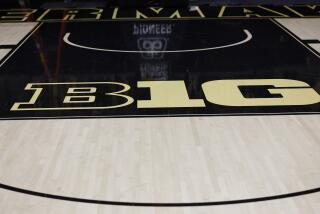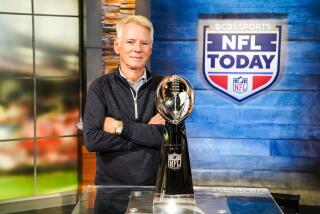Big East Boss Is So Important McGuire Remembers His Name
- Share via
NEW YORK — As an athlete, it can be reported, Dave Gavitt was not unforgettable. A case in point was his experience as a guard on the Dartmouth College freshman team, where he made such a vivid impression that the coach could not remember his name. Then again, perhaps that was a reflection on the coach, Al McGuire.
“Al then was like Al now,” Gavitt said. “He didn’t know anyone’s name. I was working like hell for two or three games to get into the starting lineup and we had a big game against Holy Cross. I must have hit seven or eight jump shots and when he pulled me out, he gave me a slap on the back and said, ‘Good job, George.”’
P.S. Gavitt never did start for McGuire, although he later teamed with Rudy LaRusso to lead the varsity to Dartmouth’s last Ivy League championship. “Now (McGuire) kids me about being a short, fat kid with a lot of heart,” Gavitt said. “I tell him he ruined my career.”
But playing was merely an introductory course for Gavitt. He made his mark as a coach (five NCAA tournaments, one Final Four in 10 years) and athletic director at Providence College, then became one of the most celebrated administrators in college sports with the formation of the Big East 10 years ago. As he presided over the annual media day in Manhattan last week, the conference’s first and only commissioner had reason to be pleased.
With Seton Hall’s appearance in the NCAA title game last spring, six of the nine members qualified for the Final Four during the league’s first decade. According to its own publicity, the Big East is the nation’s most televised college basketball conference. Its home attendance, boosted by the massive crowds attracted to Syracuse’s Carrier Dome, was second highest in the country a year ago. And now the first Big East-Atlantic Coast Conference Challenge, four doubleheaders staged on consecutive nights in early December, will bring additional glory and revenue to Gavitt’s creation.
It should be enough to satisfy any man. But Gavitt’s preoccupation with the sport has carried him beyond the bounds of his own conference. He is completing his first year as president of USA Basketball, the national governing body that recently reached a historic accommodation with the National Basketball Assn. enabling top professionals to represent the United States in the Olympic Games.
Thirty years after launching his last jump shot, almost a decade after his final coaching assignment with the 1980 U.S. Olympic team was thwarted by a boycott, Gavitt has become the nation’s No. 1 ambassador of the sport it has exported around the world. “For someone from a New Hampshire town of 1,500,” Gavitt said, “basketball has been incredible to me.”
His first exposure to international basketball, he recalled, was a pair of encounters against the Australian Olympic team in the early 1970s when Gavitt was coaching at Providence. The Aussie coach was Lindsey Gaze, whose son Andrew played a major role in Seton Hall’s remarkable NCAA tournament effort last spring. “I was struck by the different style of play,” Gavitt said.
He was struck by more than aesthetics when he took a team of young Americans, including Robert Parish, Tree Rollins and Ernie Grunfeld, to Europe in 1975 to prepare them for the Pan Am Games. “We played in the outdoor Olympic stadium in Greece at 11:30 at night,” Gavitt recalled. “There were about 25,000 people throwing things at us. It was interesting.”
The welcome for U.S. players is far more cordial today. Now the rosters of top European teams are sprinkled with Americans, some with NBA experience and others, such as Danny Ferry, recruited directly out of college. “The game is becoming global,” Gavitt noted.
Still, it’s not yet the hot ticket across the pond the way it is here. During a recent visit to Italy, Gavitt picked up a national sports daily. “It was a 40-page paper,” he said. “The first 32 pages were devoted to soccer. Basketball was on Pages 33 and 34. There were a lot of crowds around 2,000 according to the boxscores. There’s still a long way to go.”
The man knows about such journeys. When he sold the concept of the Big East to other athletic directors in the 1970s, they had little more than their own convictions that a union might make it more attractive for a blue-chip recruit to stay in the East. The schools had the advantage of location in some major media markets and the aid of ESPN, the cable network that was searching for programing in its first year. The Monday night package of Big East games satisfied the needs of both.
“Television is something we worked hard at,” Gavitt said. “We worked to understand it, to manage it. We make no apologies for that. In the entire 1970s, there were only two appearances by Eastern teams on national television. I happen to know because I coached in both of them.”
Now the Big East is a staple not only of ESPN but of CBS. Additionally, the conference established its own TV network in 1985, servicing outlets in major Eastern cities. Gavitt has served as an analyst on Big East Network telecasts, a role he will continue during the 1989-90 season. Critics have called this a conflict of interest.
“I’m not working for ESPN or for CBS. It’s our own network. And it helps me keep close to the kids. I know all the kids here,” he said, glancing around the hotel ballroom at the athletes as they were being interviewed.
“That’s important to me. It’s still their game, the kids in short pants. We’re just the caretakers. The idea is to make it as challenging and exciting as we can for them.”
Unlike his college freshman coach, Gavitt makes it a point to remember all the names.
More to Read
Go beyond the scoreboard
Get the latest on L.A.'s teams in the daily Sports Report newsletter.
You may occasionally receive promotional content from the Los Angeles Times.










